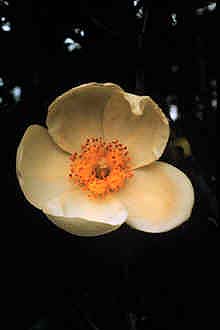
Gordonia is a genus of flowering plants in the family Theaceae, related to Franklinia, Camellia and Stewartia. Of the roughly 40 species, all but two are native to southeast Asia in southern China, Taiwan and Indochina. The remaining species, G. lasianthus (Loblolly-bay), is native to southeast North America, from Virginia south to Florida and west to Louisiana; G. fruticosa is native to the tropical rainforests of Central and South America, from Costa Rica to Brazil.

The Nocardiaceae are a family of aerobic, non-fastidious, high G+C, Gram-positive actinomycetes that are commonly found in soil and water. Members of this family have been isolated from Antarctic soils. Nocardiaceae present coccobacilli, filamentous or, rarely, fragmented and palisading forms, and filamentous species grow in a branching morphological pattern similar to fungal hyphae.

The flavanonols are a class of flavonoids that use the 3-hydroxy-2,3-dihydro-2-phenylchromen-4-one backbone.
Gordonia is a genus of gram-positive, aerobic, catalase-positive bacterium in the Actinomycetota, closely related to the Rhodococcus, Mycobacterium, Skermania, and Nocardia genera. Gordonia bacteria are aerobic, motile, and non-sporulating. Gordonia is from the same lineage that includes Mycobacterium tuberculosis. The genus was discovered by Tsukamura in 1971 and named after American bacteriologist Ruth Gordon.. Many species are often found in the soil, while other species have been isolated from aquatic environments. Gordonia species are rarely known to cause infections in humans.
Gordonia alkanivorans is a bacterium from the genus of Gordonia which has been isolated from soil which was contaminated with tar and phenol in Rositz in Germany. Gordonia alkanivorans has the ability to metabolize hexadecane. The strain RIPI90A of Gordonia alkanivorans can desulfurize dibenzothiophene.
Gordonia cholesterolivorans is a bacterium from the genus Gordonia which has been isolated from sewage sludge from a sewage treatment plant in Ciudad Real in Spain. Gordonia cholesterolivorans has the ability to degrade cholesterol.
Gordonia desulfuricans is a benzothiophene-desulphurizing bacterium from the genus Gordonia which has been isolated from soil from West Calder in Scotland.
Gordonia hankookensis is a Gram-positive, aerobic and non-motile bacterium from the genus Gordonia.
Gordonia humi is a Gram-positive and non-spore-forming bacterium from the genus Gordonia which has been isolated from soil near the mushroom Agaricus brasiliensis in Taiwan.
Gordonia jinhuaensis is a Gram-positive, aerobic, rod-shaped and non-motile bacterium from the genus Gordonia which has been isolated from pharmaceutical wastewater from Jinhua in China.
Gordonia lacunae is a bacterium from the genus Gordonia which has been isolated from soil from the Plettenberg Bay in South Africa.
Gordonia namibiensis is a bacterium from the genus Gordonia which has been isolated from soil from Kalahari in Namibia. Gordonia namibiensis metabolises nitrile.
Gordonia neofelifaecis is a bacterium from the genus Gordonia which has been isolated from faeces from the leopard in the Sichuan Province in China.
Gordonia paraffinivorans is a bacterium from the genus Gordonia which has been isolated from the Daqing Oil Field in China. Gordonia paraffinivorans has the ability to degrade hydrocarbon.
Gordonia rhizosphera is a bacterium from the genus Gordonia which has been isolated from rhizosphere soil from a mangrove plant in Japan.
Gordonia sihwensis is a Gram-positive and nitrate-reducing bacterium from the genus of Gordonia which has been isolated from an autotrophic denitrification reactor in Sihwa in Korea.
Gordonia sinesedis is a bacterium from the genus of Gordonia that has been isolated from soil.
Gordonia soli is a bacterium from the genus of Gordonia which has been isolated from soil in Taiwan.
Saccharopolyspora shandongensis is a bacterium from the genus Saccharopolyspora which has been isolated from wheat field soil in Shandong in China.
Gordonia sp. nov. Q8 is a bacterium in the phylum of Actinomycetota. It was discovered in 2017 as one of eighteen new species isolated from the Jiangsu Wei5 oilfield in East China with the potential for bioremediation. Strain Q8 is rod-shaped and gram-positive with dimensions 1.0–4.0 μm × 0.5–1.2 μm and an optimal growth temperature of 40 °C. Phylogenetically, it is most closely related to Gordonia paraffinivorans and Gordonia alkaliphila, both of which are known bioremediators. Q8 was assigned as a novel species based on a <70% ratio of DNA homology with other Gordonia bacteria.


